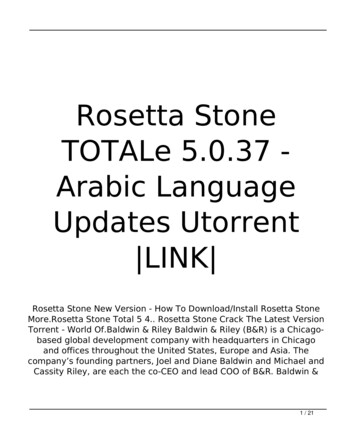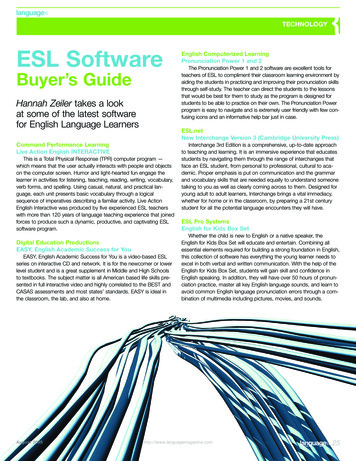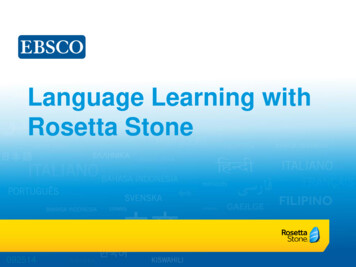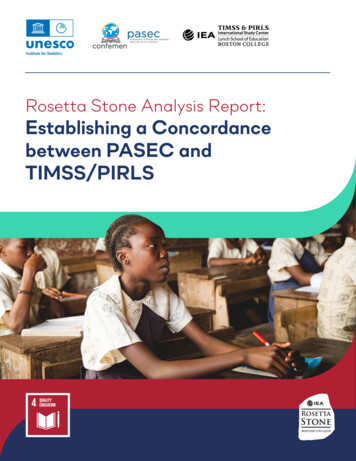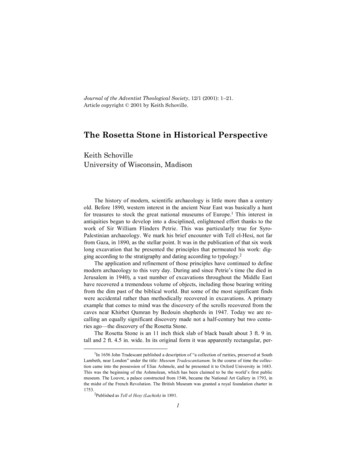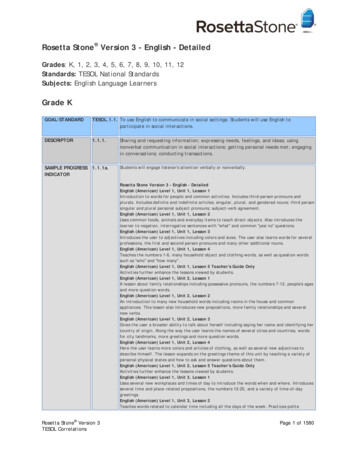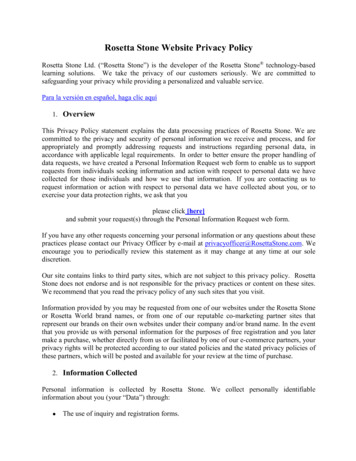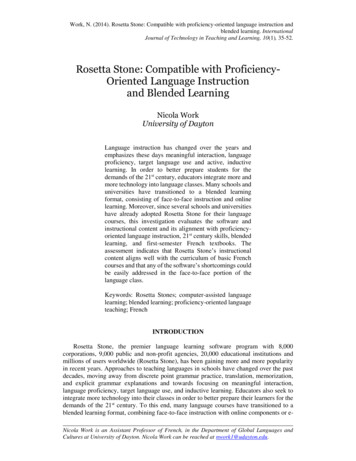
Transcription
Work, N. (2014). Rosetta Stone: Compatible with proficiency-oriented language instruction andblended learning. InternationalJournal of Technology in Teaching and Learning, 10(1), 35-52.Rosetta Stone: Compatible with ProficiencyOriented Language Instructionand Blended LearningNicola WorkUniversity of DaytonLanguage instruction has changed over the years andemphasizes these days meaningful interaction, languageproficiency, target language use and active, inductivelearning. In order to better prepare students for thedemands of the 21st century, educators integrate more andmore technology into language classes. Many schools anduniversities have transitioned to a blended learningformat, consisting of face-to-face instruction and onlinelearning. Moreover, since several schools and universitieshave already adopted Rosetta Stone for their languagecourses, this investigation evaluates the software andinstructional content and its alignment with proficiencyoriented language instruction, 21st century skills, blendedlearning, and first-semester French textbooks. Theassessment indicates that Rosetta Stone’s instructionalcontent aligns well with the curriculum of basic Frenchcourses and that any of the software’s shortcomings couldbe easily addressed in the face-to-face portion of thelanguage class.Keywords: Rosetta Stones; computer-assisted languagelearning; blended learning; proficiency-oriented languageteaching; FrenchINTRODUCTIONRosetta Stone, the premier language learning software program with 8,000corporations, 9,000 public and non-profit agencies, 20,000 educational institutions andmillions of users worldwide (Rosetta Stone), has been gaining more and more popularityin recent years. Approaches to teaching languages in schools have changed over the pastdecades, moving away from discrete point grammar practice, translation, memorization,and explicit grammar explanations and towards focusing on meaningful interaction,language proficiency, target language use, and inductive learning. Educators also seek tointegrate more technology into their classes in order to better prepare their learners for thedemands of the 21st century. To this end, many language courses have transitioned to ablended learning format, combining face-to-face instruction with online components or eNicola Work is an Assistant Professor of French, in the Department of Global Languages andCultures at University of Dayton. Nicola Work can be reached at nwork1@udayton.edu.
Rosetta Stone: Compatible with Language Instruction and Blended Learning 36learning. In the past few years, several schools and universities have started using RosettaStone in their language classes. It is the objective of this paper to review the softwareprogram and its instructional content and to evaluate whether it aligns with proficiencyoriented language instruction, 21st century skills, blended learning, and first-semesterFrench textbooks.LITERATURE REVIEWAPPROACHES TO LANGUAGE TEACHINGOver the years, language educators seem to have continuously been trying to find theone best way for teaching a foreign language. However, the history of the teachingprofession has been marked more often by controversy than by consensus. Often, newmovements emerged, captured the attention of many educators, caused an upheaval inmethods and materials, and then faded from view (Grittner, 1990). During the so-called“Age of Methods” from the 1950s to the 1980s, a number of different prescriptions forlanguage teaching emerged. Situational Language Teaching evolved in the UnitedKingdom while Audio-Lingualism emerged in the United States. Several methodsdeveloped during this period as successors to these existing methods such as Silent Way,Suggestopedia, Community Language Learning, and Total Physical Response. In the1980s, many practitioners and language educators still felt the need to reach someconsensus about language teaching and more interactive ways of teaching language cameabout which collectively are called Communicative Language Teaching. This approachcaused several spin-off approaches to come about such as The Natural Approach,Cooperative Language Learning, Content-Based Teaching, and Task-based Teaching. Inan effort to establish uniform goals and standards for language proficiency, the ACTFLproficiency guidelines were developed in 1986. Instead of looking for one definitiveapproach to teaching, educators have begun looking for some organizing principle tofacilitate the development of goals and objectives for language teaching. For a detaileddescription and comparison of these methods and approaches of language and teaching,see, for instance, Cook (2013); Larsen-Freeman & Anderson (2011); Richards & Rodgers(2001); Whong (2011).PROFICIENCY-BASED LANGUAGE TEACHINGIn an attempt to identify some guiding principles for organizing and planninginstruction in a foreign language, Omaggio (1983) derived five hypotheses that encompassthe essence of proficiency-based language instruction and apply to any level of proficiency.Based on Omaggio’s original hypotheses and associated corollaries and her more recentextension (Hadley, 2001), a brief description of proficiency-based language teaching willbe provided. It has to be noted, however, that proficiency-oriented language teachingrepresents a general framework for organizing instruction, curriculum and assessmentrather than a method or theory.Input. Students need to have opportunities to learn a language in context and applytheir knowledge in real-life situations. This provides opportunities to practice language inmeaningful discourse rather than using disconnected word lists and isolated sentences.Thus, lessons should be unified thematically, presenting new vocabulary and expressionsin context. This should include teaching the cultural connotations of these words andexpressions to create an understanding how their meaning is embedded in the culture ofthe people that speak the language (Hypothesis 5). Furthermore, like many other recentmethods/approaches, authentic language should be used in the classroom and outside
International Journal of Technology in Teaching & Learning37(Hypothesis 1). This includes authentic written language samples such as stories, articles,recipes, website, and blogs as well as spoken language samples such as TV, native speakerdialogs, podcasts, and songs, all available on the internet. Cultural comparisons anddiscussions should also be based on authentic cultural material and realia. Finally, oneshould not forget the natural language that is provided by the language teacher each day inclass.Output. Students should be encouraged to express their own meaning in personalized,communicative activities. Using language for a real purpose means students need to learnto create with the language, to use it imaginatively instead of always focusing on mainlymanipulative language practice. This includes paraphrasing, thinking up a variety ofpossible answers, letting students be resourceful and original with the language. Thatmeans, after providing students initially with some vocabulary and expressions, the targetlanguage should be used immediately in creative, personalized ways (Hypothesis 1).Students need to perform a variety of functional tasks that have been carefully sequencedand are integrated into the various lessons in order to be able to cope with the real-worldcommunication demands they will face. These tasks or operational language learning goalsinclude greetings, describing their own identity and preferences, ordering food, makingpurchases, to name but a few (ACTFL). Apart from speaking, the other modalities(listening, reading, and writing) need to be equally incorporated into proficiency-orientedlanguage classes (Hypothesis 2).Student role. A student-centered classroom with plenty of small group and pairedcommunicative activities is essential for proficiency-based teaching. This allows studentsto practice language in context and for real communicative purposes to further developtheir oral proficiency. Communicative activities among students are most effective if theyinvolve the actual exchange of information, i.e. using language as a means to an end. In astudent-centered classroom, learners take an active, involved role in the learning processand take (some) responsibility in their learning. Student activities should involve activecognitive processes such as creating, problem-solving, reasoning.Teacher role. In a student-centered classroom, the teacher’s main role is to help andencourage students to develop their skills, rather than merely transmitting information bylecturing (Jones, 2007). During partner and group activities teachers circulate in theclassroom to offer assistance, keep students on task, make note of problems and providefeedback. As learners produce language, various forms of instruction and evaluativefeedback can be useful in advancing their skills towards more precise and coherentlanguage use. Thus, there is a role for form-focused instruction in a proficiency-basedapproach, but it has to be used in conjunction with communicative language teachingpractices (Hypothesis 3). Finally, language instruction needs to respond to not only thestudents’ affective and cognitive needs but also their different personalities, theirpreferences and individual learning styles also need to be taken into account (Hypothesis4). Galloway & Labarca (1990) sum it up nicely: “What is called for is not a teachingmethod, but a teaching repertoire.” (p. 115).TECHNOLOGY AND BLENDED LEARNING21st century learning and the use of technology. Concerned about preparing today’sstudents for tomorrow’s world, the Partnership for 21st Century Skills and the InternationalSociety for Technology in Education have drafted frameworks and guidelines outliningwhat students need to know to meet the challenges of the modern world. In addition to coresubjects (such as language arts, math, science and history), these two organizationsemphasize the importance of including 21st century interdisciplinary themes (such as globalawareness, financial, economic, business and entrepreneurial literacy, civic and health
Rosetta Stone: Compatible with Language Instruction and Blended Learning 38literacies,) and weaving 21st century skills (such as creativity and innovation,communication and collaboration, research and information fluency, critical thinking,problem solving and decision-making) into core subjects. The 21st century skills can bedivided into three categories: (1) learning and innovation, (2) digital literacy skills, and (3)career life. The first category encourages (a) the creation of meaningful and authenticassessment and activities that promote higher order thinking skills and (b) the integrationof lifelong skills and content into lessons, units, and activities. The second categoryemphasizes the need to incorporate technology into the classroom. Finally, the thirdcategory underlines the need to work effectively and creatively with team members.As one of the 21st century skills and demanded by the digital age, the integration oftechnology into language teaching, language curricula, and assessment is necessary.Besides preparing students for the demands of the digital age, there are many other reasonsfor integrating technology into the language classroom. Students are generally technologyliterate and have become accustomed to using it. Technology can assist and enhancelanguage learning and differentiates instruction. Since students learn at different rates andhave different learning styles, technology can help reach all students in different ways.Technology can engage students to be active participants and to be involved in meaningful,interactional activities. Using technology also motivates students and provides theopportunity to work collaboratively as a team. Furthermore, technology can help relate thecurriculum to life outside of the classroom, connect US classrooms to classrooms abroad,and provide authentic language and samples of the target language. In this sense, it makeslanguage study practical and significant giving students a chance to actively use thelanguage for real purposes. Finally, technology can add many dimensions to the languageclassroom.BLENDED LEARNINGBlended learning refers to a combined teaching method, namely a combination ofstandard face-to-face teaching with online components or e-learning (Hubackova,Semradova, & Frydrychova, 2011). This incorporation of online learning in classroomeducation has been referred to by other terminology such as web-enhancement, mixedmodes, computer-mediated communication, or hybrid learning. Two basic types ofteaching can be combined with this approach: synchronous and asynchronous teaching.Synchronous teaching refers to teaching in real-time where students experience learningsimultaneously and can react mutually. Asynchronous teaching, on the other hand, happensat different times to different students where they can choose their individual pace, butcannot react mutually in real-time (Hubackova et al, 2011). There are three differentapproaches to blended learning: (1) storage space, (2) web as add-on, and (3) “perfectblend” (Scagnoli, 2005). First, educators might use the online component merely as storagespace for students to have access to all course materials on the web. In the second approach,new materials are taken from the web and web-enabled tools and applications are used toenhance classroom learning. Finally, in the perfect blend, classroom and web complementeach other. Here, the web is used to enhance classroom teaching in that the materials fromthe web and the materials from the face-to-face classroom are perfectly integrated(Scagnoli, 2005).There are many advantages of using blended learning in foreign language teaching,especially in a time, when the face of education is rapidly changing. First and foremost,blended learning encourages the use of technology, preparing students for the demands ofthe 21st century outside of class. The online component allows easy inclusion of manyaudio and video files as well as authentic language and culture into the class. It encouragesand motivates students to learn, making language-learning creative, and fun. In an online
International Journal of Technology in Teaching & Learning39environment, students choose the time, place to study, and have 24-hour access allowingflexibility in their schedules. In addition, different learning styles can easily beaccommodated in the online part. In a blended learning environment, students can learnand use the language when they are not physically in class, thus extending learning tooutside of class. Class time can then be used for valuable communication among learnersand with the teacher, for the practice of language functions, and for the integration of theonline content. This way, learners still have access to the teacher, consulting them andcommunicating with them in class.Among the disadvantages of a blended learning approach is, primarily, the difficultyto create well-integrated blended learning courses, i.e. where the online content perfectlyenhances the face-to-face portion of a class. Moreover, there is a constant need for bothfaculty and students to learn about new technologies and receive training in how to usethem effectively. In addition, even though we live in an age of technology, there areeducators and students who are reluctant to use new technologies. Blended learning coursesmight then become frustrating for students who lack the necessary technology skills toparticipate in such practices. At the same time, educators might be frustrated by having tochange their traditional teaching method to a blended one, having to learn to use technologyand encourage students to do the same. Due to the learning curve of some technology tools,blended learning might be more time-consuming (at least in the beginning) for bothteachers and learners.Most importantly, though, blended learning has to be about improving and enhancinglearning, about helping students learn how to build new knowledge using this combinationof traditional face-to-face classrooms and new online tools to gain proficiency in theforeign language.ROSETTA STONE AND SUGGESTED ACTIVITESRosetta Stone, a commercially available, stand-alone, all-in-one language learningsoftware package, which used to be mainly utilized by US government employees, hasbeen gaining more and more importance among language learners in all different situations.First introduced in 1996, the first version of Rosetta Stone featured nine level-one languagecourses (Dutch, English, French, German, Italian, Mandarin Chinese, Portuguese, Russian,and Spanish) and four level-two courses (English, French, German, Spanish). The currentversion 4 TOTALe was released in September 2010 and is a software suite containingRosetta Course (core language-learning lessons), Rosetta Studio (live sessions with anative speaker), Rosetta World (interactive social language-learning community withgames), and TOTALe Mobile Companion (supplemental lessons for on-the-go). It iscompatible with Windows and Mac-based computers with anywhere access on any webenabled Windows or Mac device or with mobile apps on iPhone, iPad and Android devices.According to Rosetta Stone’s website, there are “millions of satisfied learners, 8000corporations, 900 public and non-profit agencies, 20000 educational institutions andmillions of learners worldwide” who use the language learning software (Rosetta Stone).ROSETTA COURSE FRENCHRosetta Stone version 4 French consists of a total of five levels; each level is comprisedof four units; and in each unit, there are four core lessons and one milestone. The durationto complete a level in Rosetta Stone is roughly 40-50 hours. Each lesson contains generallythe following components: a core lesson, pronunciation, vocabulary, grammar, reading,writing, listening, and speaking.
Rosetta Stone: Compatible with Language Instruction and Blended Learning 40Figure 1: Rosetta Stone TOTALe Version 4, main menu (Rosetta Stone, 2014).The TOTALe main menu in Figure 1 above is the spring board into the languageprogram with the levels and lessons in the upper left corner, with the Rosetta Worldextensions ‘play’, ‘talk’, ‘explore’ in the bottom left corner, with the cultural informationblurbs rotating in the bottom right corner and with a link to schedule a session with a nativespeaker (Rosetta Studio) in the upper right corner.Core lesson. The core lesson contains all the new vocabulary, grammar, and functionsof a lesson. New items are introduced in an inductive manner using pictures and previouslyacquired items. On some screens, learners see pictures associated with words and areprompted to provide a missing piece to the puzzle. Sometimes a native speaker says wordsor phrases (with or without additional written prompt) and the learner selects theappropriate picture. In Unit 1 Lesson 2, for example, the core lesson contains the followinginstructional content: food vocabulary, people and animals, verbs such as eating, drinking,driving, walking, sleeping, subject pronouns, negation and basic questions and answers.Figure 2. Speech recognition window with waves of native speaker and learnerpronunciation (Rosetta Stone, 2014).Pronunciation. The pronunciation activity allows learners to work on theirpronunciation of the new vocabulary by repeating after a native speaker and recording theirattempts. Often, words will be broken down into syllables to practice pronunciation and tocontrast them with similar syllables. Syllables such as poi-sson, po-li-cier, so-leil, sty-lo,bu-vez are, for instance, practiced in Unit 1 Lesson 3. Moreover, issues such as liaison (thepronunciation of a latent word-final consonant immediately before a following vowel
International Journal of Technology in Teaching & Learning41sound) and elision (the suppression of a final unstressed vowel (usually [ə]) immediatelybefore another word beginning with a vowel) are also the focus of the pronunciationactivities. Elisions such as je m’appelle and comment tu t’appelles are two examplesintroduced in Unit 2 Lesson 3. Phrases such as mon ami, nos enfants and dix ans areexamples of French liaison and are the focus of the pronunciation activity in Unit 2 Lesson1. The speech recognition software as shown in Figure 2 evaluates learners’ pronunciationin all of these types of activities, allowing learners to compare their pronunciation to thatof native speakers.Vocabulary. The vocabulary activity practices the new vocabulary with pictures,recycling previously introduced material to teach new words by elimination. The nativelanguage of the learners is never utilized to present new vocabulary. The word orexpression (or in later stages, sentence) is written in French on top of the screen andpronounced by one of several native speakers, both male and female. The learner selectsfrom several pictures on the page the one described by the word or expression. Learnershave the option to listen to the new vocabulary item as often as needed. In Unit 1 Lesson1, the first vocabulary lesson, nouns such as femme, garçon, homme, fille and verbs likeboire, courir, lire, écrire, manger are introduced among others.Grammar. The grammar activity focuses on the grammar and structures from the corelesson where learners select captions for pictures choose from drop-down menus, select theappropriate subject or verb conjugation, listen, and select pictures. Frequently, learners areasked to choose the correct grammatical form from a drop-down menu, such as theappropriate article or verb form (see Figure 3). The sentence with the blank is initiallypronounced by the native speaker; once the correct form is selected, the entire sentence ispronounced again. Grammar is also practiced by presenting a picture and learners selectingthe appropriate caption among several options. Finally, learners are asked to pronounce thecorrect sentence or phrase.Figure 3. Grammar lesson, Unit 1 Lesson 2 (Rosetta Stone, 2014).In Unit 1 Lesson 2, for example, the verb forms of the verb avoir, the partitive article de l’,du, the negative particle de, d’ and the negation ne pas are practiced.
Rosetta Stone: Compatible with Language Instruction and Blended Learning 42Reading. The title ‘reading’ for this section seems a bit misleading for today’seducators. It does not focus on reading for understanding, but rather on dividing words andphrases into syllables and distinguishing them from other, similar syllables. It focuses indetail on some of the newly introduced vocabulary providing learners with opportunitiesto pronounce and hear difficult and similar syllables and sounds.Figure 4. Reading Activity, Unit 1 Lesson 2 (Rosetta Stone, 2014).In Unit 1 Lesson 2, for example, words such as café, chat, court and conduit are pronouncedas well as key syllables from these words like cha-, ca-, cou-, con- (see Figure 4). Afterworking on the pronunciation, learners hear a syllable and have to select in writing thesyllable they heard.Speaking. The speaking activity has learners initially repeat after the native speakersand then make them say their own sentences like answers to questions, or asking questionsor describing the picture. Most of the time learners repeat words, phrases, or sentences afternative speakers and recording their answers. The voice recognition software then acceptsor rejects each of the attempts, often prompting the learner to pronounce a word repeatedly(see Figure 2 above). The prompts are pronounced by different native speakers, both maleand female. Then, learners are asked to speak without a prompt following a model. In Unit1 Lesson 3, for example, greetings bonjour and au revoir and verb forms boit, boivent,écrit, écrivent, court, courent are practiced.Listening. The listening activity focuses on the learner’s listening skills asking themto hear sentences and phrases taken from the core lesson and to select the appropriatepicture depicting the action or item. In this type of activity, there are no written prompts,but learners can hear the aural prompt as often as needed. Sentences such as Le garçon boitdu lait, elle lit un livre or les adultes courent are practiced in Unit 1 Lesson 2.Writing. Finally, the writing activity reviews the previously encountered vocabularyand grammar, and reviews pronunciation. Then, learners choose syllables from drop-downmenus to complete sentences and phrases or type entire words, phrases and sentences. InUnit 1 Lesson 2, vocabulary from the lesson is first recycled by giving a written prompt
International Journal of Technology in Teaching & Learning43and learners selecting the corresponding picture. Next, some syllables are practiced byhearing a given syllable’s pronunciation and picking the given spelling of this syllable fromwords from the lesson. Finally, learners hear a prompt and type what they hear, forexample, un journal, un café, and il conduit. At the end of the following lesson will be areview of the previous lesson. All of these components comprise Rosetta Course.ROSETTA STUDIO FRENCHIn addition to Rosetta Course, the core-language learning portion of the program,learners have access to Rosetta Studio and Rosetta World (see Figure 1 above). RosettaStudio allows learners to practice language in a real-time setting through live sessions witha Studio Coach who is a native speaker of the language. Through TOTALe online services,learners have access to 4 25 minutes live, online sessions per month with the Studio Coachand up to 3 other learners. Private one-on-one sessions are also available. These sessionsare entirely in the L2 focusing on the material covered in the lessons/units and beyond. Thelearner uses a microphone to communicate with the Studio Coach who is connected viavideo to the learner so that visual cues can be given to the learner, but the learner’s identityremains hidden.ROSETTA WORLD FRENCHRosetta World represents an interactive social language learning community wherelearners have the opportunity to play language games either by themselves or with a partnerto practice the new language skills. A chat room is also available to make connections withother people learning the same language. This component of Rosetta Stone contains 3sections: (1) play, (2) talk and (3) explore. In the play section, learners can play games bythemselves or with other learners to work on their listening, reading, writing skills and topractice grammar, vocabulary and pronunciation. In Buzzbingo, learners hear a story andclick on all the words on the bingo card they hear. The story is purposefully at least i 1and contextualized to challenge learners’ listening skills. In Picari, learners hear a promptand pick the matching picture from a stack. Super Bubble Mania focusses on hearingsyllables: learners pop the bubbles in the color of the syllable they hear. Finally, MemGois a memory game where learners match a phrase or sentence with a picture.In the talk section, learners engage in speaking or typing with a partner throughcollaborative games. In Identi, learners have a name tag with a picture and have to describethemselves. The partner guesses the character. In Contrasto, the two players have each apicture of a scene that they need to describe in order to find the differences between thetwo scenes. This can be done either in speaking or in writing. In MetaTag, partners describethe same picture in writing, if they use the same word, they earn points. In Replica, thepartners will see slightly different scenes. The learner with the full scene describes it andthe partner drags the missing items onto his scene. Finally, there is an open conversationwhere partners can talk; if needed with prompts. The explore section contains interactivestories written and narrated by native speakers that supplement the lessons. Learners havethe option to read and listen to the story, to only listen to the story and to read and recordthe story.ALIGNMENT WITH BASIC FRENCH COURSESIn order to evaluate how well Rosetta Stone aligns with basic French programs, thevocabulary, functions, grammar and culture were taken from Horizons, an introductory,college-level French book, and compared to the instructional content of Rosetta Stone.
Rosetta Stone: Compatible with Language Instruction and Blended Learning 44Since most introductory French textbooks follow a similar sequence, the interpretation ofthis comparison is valid for most beginning French courses even when not using Horizons.Rosetta Stone Units 1-3 align generally very well with the content of a basic Frenchuniversity first-semester course or secondary school first-year course. First of all, RosettaStone and Horizons generally introduce the same vocabulary and themes, such as numbers,colors, adjectives, clothing, furniture, housing, family, personal belongings, food,greetings, days of the week (see Appendices A and B). However, there are a few themesthat are not part of the first part of Rosetta Stone, but that can be found in basic Frenchtextbooks. Classroom vocabulary, classroom communication, university vocabulary andfields of study as well as the alphabet, for instance, do not exist in the early units of RosettaStone. This is understandable since Rosetta Stone, for one, is a language-learning programgeared toward any language learner, not necessarily only college students. Also, some ofthese themes are not applicable early on in an immersion setting, where the goal is to getlearners to use the language quickly. However, Rosetta Stone offers some additional wordthemes such as professions, languages, animals, surroundings, countries, body parts,seasons that are not necessarily part of first-semester introductory French courses. In termsof grammar, Rosetta Stone and basic French textbooks are very similar (see Appendices Aand B). Structures such as indefinite and definite articles, basic and high frequency verbs,adj
Rosetta Stone: Compatible with Language Instruction and Blended Learning 36 learning. In the past few years, several schools and universities have started using Rosetta Stone in their language classes. It is the objective of this paper to review the software program and its instructional content and to evaluate whether it aligns with proficiency-


